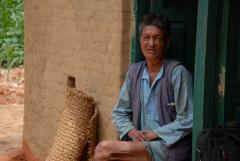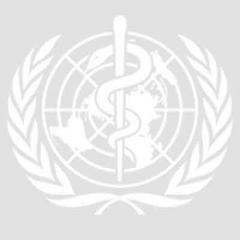Your progress
0%
Here are some of the key ideas about CBR and leprosy.
Use your mouse or keyboard to expand each of the headings below.
What is leprosy?
Leprosy is a disease caused by the bacterium Mycobacterium leprae, which mainly affects the skin and nerves. Leprosy is often called Hansen’s disease, after the person who discovered the bacterium. It can affect people of both sexes and of all ages. It progresses very slowly, and it can therefore take many years before noticeable signs and symptoms appear. One common sign of leprosy is “skin patches”, which are pale, reddish or copper-coloured. These areas of skin may be flat or raised and have no sensation. They may appear anywhere on the body, and usually do not itch or hurt.
Common myths about leprosy
While awareness and knowledge about leprosy have improved over time, there are still some common myths. These include the following:
Over the past 20 years, more than 14 million people have been cured. WHO provides MDT for any country that needs it as part of the organization’s ongoing efforts to eliminate leprosy. Treatment is available free of charge at health centres.
Leprosy reactions
Some people with leprosy may experience “leprosy reactions”. These are part of the body’s response to leprosy and do not mean that the disease is becoming worse or that the treatment is not working. Rather, they are like an allergic reaction – the body reacts against the presence of leprosy bacteria, and in doing so can cause damage to its own tissues. Leprosy bacteria target nerves, which are often damaged during leprosy reactions. Nerve damage can occur very quickly, and therefore early detection and referral to appropriate health services for treatment is very important to prevent irreversible damage. Early detection and treatment of nerve damage are the great challenges of leprosy control programmes. Up to 30% of people affected by leprosy are at risk of reactions and nerve damage.
Impairments associated with leprosy
Nerve damage associated with leprosy can lead to a wide range of impairments. Nerve damage can result in sensory impairments, such as losing feeling in hands and feet. Nerve damage can also result in motor impairments, with a person’s hands, feet or eye muscles becoming weak or paralyzed. Leprosy also often causes the skin to become very dry because of damage to the nerves which control sweating. For many people, these impairments can then lead to further problems and complications. Some examples of the complications include the following:
Functional impact
The impairments associated with leprosy can make it very difficult for people to carry out daily activities. For example, people who lose feeling or strength in their hands will have more difficulty with simple tasks, such as threading a needle or holding a spoon; and people who are unable to lift their foot (“foot drop”) will have difficulty walking. An estimated 20–25% of people affected by leprosy experience additional disability. Early detection of leprosy and proper treatment combined with regular check-ups are key to preventing disabilities.
When you are finished reading this story, consider:
Then enter your own thoughts about this below. Select Save when you are finished.
Social impact
Often, it is not the physical impairments or even the functional limitations that cause the greatest problems for people affected by leprosy. Instead, stigma and social exclusion have the greatest impact. People who are visibly affected by leprosy are often unable to find work or marry, and are therefore dependent on others for financial support and care. Self-stigma is also common – people start blaming themselves for their disease, which results in feelings of worthlessness and loss of self-esteem, hope and purpose. Often, even people who have been cured of leprosy will continue to experience the ongoing effects of stigma and discrimination.
Women with disabilities are often more vulnerable and disadvantaged in society. This is also true for women with leprosy. A general lack of awareness and knowledge within communities about leprosy, namely, whether it is inherited, infectious or curable, has an impact on relationships, marriage and family. Many women have been abandoned by their spouses after a leprosy diagnosis, particularly if they were only recently married, and for many unmarried women leprosy can severely restrict their marriage prospects.
People affected by leprosy are often excluded from active involvement in services specifically designed for them.
Learn about how one man in Nepal overcame the social stigma that can follow leprosy.


For more than 40 years, Megh Bdr Tamalsina has lived with the consequences and damages caused by leprosy. Megh received treatment and care from The Leprosy Mission Hospital in Anandaban, Nepal. Once he was healed from leprosy, he returned to his village. But Megh was not received with open arms and the villagers did not allow him to participate in any of the community’s activities or celebrations any more.
Megh joined a self-help group and a self-care group. In these groups he learned how to care for his ulcers and how to prevent further injuries. He also learned how to cook without burning himself and how to gain a small income though goat rearing.
Megh and his wife lived for many years in dilapidated conditions and great poverty. The local CBR was able to find funds for housing for very poor people. Now, the house gives them more recognition in the community and is a provision for their old age.
Economic impact
Leprosy can have a considerable economic impact on individuals and their families. People may be unable to work or may not be able to continue working because of impairments associated with leprosy. People may also lose their jobs because of the stigma related to leprosy. Other people are often reluctant to buy goods, such as food products from a person affected by leprosy, for fear of contamination. There are also many treatment-related costs that people with leprosy are burdened with: while drug treatment is free, access to health care in low-income countries is often associated with travel costs and loss of wages. There may also be additional treatment costs such as hospital admissions or the purchase of protective footwear, orthoses or prostheses. Many people may be discouraged from accessing services because of these many costs. As a result, they may develop secondary conditions and the impact of their disability may increase.
Learn about how a young woman affected with leprosy worked to support her family.


Bangladesh is a male-dominated society where women with disabilities – particularly those with leprosy – are very vulnerable. The Leprosy Mission is an integral partner of a food security project working with 40,000 female-headed households to ensure that women affected by leprosy can provide for themselves and their families.
Parvin is one of the people who have benefited from the project. She explained: “Six years ago my husband Shajamya was paralyzed by a spinal cord injury. I had to sell off all our assets and land to pay for his treatment, but he still couldn’t be cured. We ended up with no income and no possessions and could scarcely manage to eat two meals a day. My daughter was forced to leave school and we both became maidservants to survive. Shajamya was left alone for many hours and rarely left the house. Life was unbearable. It was under those circumstances that help from the project transformed our lives.”
Parvin received three months training in tailoring and was given a sewing machine and materials. She started working in a tailoring shop earning just less than £10 a month. Within six months she established her own shop and her garments are now in high demand. Her earnings have doubled and she has started to build up some savings.
Footnote:
This story was retrieved from http://www.leprosymission.org.uk/about-us-and-leprosy/how-we-help/case-studies/parvin-begum-bangladesh/
Leprosy colonies
Until a few decades ago, there was no effective cure for leprosy. Therefore, people affected by the disease were usually isolated in leprosy colonies or leprosariums. This segregation was often enforced by law. As effective treatment and cure became available, many of these colonies were closed. However, they still exist in some countries. Some people living in these settlements may be long-term residents with no contact with family members from their former family homes. Those with severe disabilities may be dependent on begging or charity.
Leprosy in India
India has always had the largest population of people affected by leprosy. In 2005, an organization of people affected by leprosy conducted a national survey of leprosy colonies in India. This study revealed that 700 leprosy colonies still existed and approximately 200,000 people affected by leprosy and their family members were living in these colonies. Of these, around 25,000 people were making a living by begging. In many colonies, there were no toilet facilities, drinking water, approach roads or education facilities. Surrounding communities avoided people living in these colonies, and as a result they had difficulty accessing public transport and other public facilities.
It is important that governments and non-governmental organizations support the integration of people affected by leprosy into their local communities, making them aware of their rights and working with them to remove stigma and discrimination.
CBR can play an important role in this process. When resettlement in the community is not an option, such as if people are unwilling to leave leprosy colonies, CBR can help them to live in harmony with surrounding communities and gradually open up their own colonies to accommodate other people. There are examples around the world where leprosy colonies have gradually evolved into ordinary villages.
Learn about how a leprosarium in Brazil grew into a thriving community with the support of the local government.


In the late 1980s, a leprosarium in Manus, north-west Brazil, was closed and people affected by leprosy were resettled on the periphery of the city in Lago de Aleixo. At this time, there was little infrastructure in Lago de Aleixo and very few services – there was no drinking water and no school. With support from the local church, people affected by leprosy came together and formed a cooperative to address these issues. They started a brick factory and a water distribution system. As the community grew stronger, they also started a chicken farm, restaurant and school. The community began to grow, and as the Government provided additional infrastructure and services, other people gradually came and settled there. Today, Lago de Aleixo is part of the city, and many people do not know that it was once a leprosy settlement.